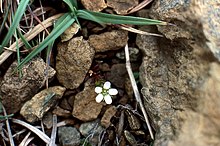|
Arenaria norvegica
Arenaria norvegica, also known as Arctic, English or Norwegian sandwort, is a low growing plant in the family Caryophyllaceae, found in northwest Europe. The diploid chromosome number is 2n=80. There are two recognised subspecies.[1] DescriptionArenaria norvegica is a much branched, low-growing plant growing up to six centimetres tall. The midrib of the leaves is indistinct and the margins glabrous only in the lower third which distinguishes it from the rather similar Arenaria ciliata.[1]
Arenaria norvegica subsp. anglica is an annual or biennial with few non-flowering shoots. The leaves are opposite, narrowly ovate or elliptic. The flowers are eleven to twenty-three millimetres in diameter, have five white petals and three styles.[1] The plant flowers from May to October.[2]
Arenaria norvegica subsp. norvegica is a perennial with many non-flowering shoots. The leaves are obovate and the white flowers about ten millimeters across with five petals and three to five styles.[1] DistributionBoth subspecies are uncommon and localised. HabitatArenaria norvegica subsp. anglica favours thin peaty soils in cracks, depressions or hollows on limestone rock. It is also found growing in moist calcareous flushes and in gritty soil at the edge of tracks. It typically grows among small sedges, fescue grass and other members of the pearlwort and sandwort genera. It is classified as a vulnerable endemic species in the vascular plant British Red Data Book.[2] Arenaria norvegica subsp. norvegica is found on base-rich (alkaline) sandy and gravelly substrates [4] including those derived from ultrabasic igneous rocks and serpentine as well as limestone.[3] References
|
||||||||||||||||||||||||||
